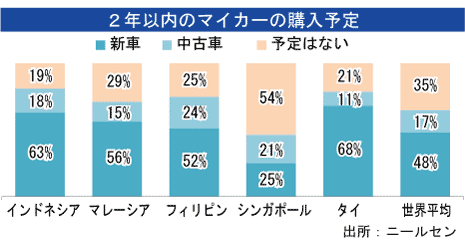ASEAN-led ★ Rising car demand, among the highest globally
 |
According to Nielsen research, Southeast Asian consumers show the highest global intent to purchase automobiles. Approximately 80% of respondents in Indonesia and Thailand (81% and 79% respectively) plan to buy a car within the next two years. In the Philippines, 76% expressed purchase intent, exceeding the global average (65%).
 |
Conversely, Southeast Asia's car ownership rate (including leases and rentals) is lower than other regions. The Philippines (47%) and Indonesia (46%) had particularly high proportions of non-owning households, ranking fifth and sixth lowest globally (among the 60 surveyed countries/regions).
The sole exception was Malaysia. It had the world's third-highest rate of car ownership at 93%, and also had the world's highest proportion of households owning two or more cars at 54%. The proportion owning two or more cars was 27% in Thailand, 16% in the Philippines, 9% in Indonesia, and 7% in Singapore. The global average was 20%.
The majority of Southeast Asian car owners cited "transportation to destinations" as the primary role of their vehicle. The percentage of respondents exceeding 80% was seen in Singapore (88%), the Philippines, Indonesia, Malaysia, and Thailand.
While the practical aspect is strong, many also view "cars as a symbol of success in their lives." In Thailand, 79% (2nd globally) answered that a car is a "symbol of success in life." The Philippines ranked 5th globally at 72%, and Indonesia 10th at 67%. Malaysia was 62% and Singapore 54%, both exceeding the global average of 52%.
Chang Park, Managing Director of Nielsen's Automotive Division for Southeast Asia, North Asia, and the Pacific, analyzed, "In Southeast Asia, private cars, previously positioned as expensive items, are becoming more accessible due to rising incomes driven by economic development." He pointed out that Southeast Asia will support the global automotive market over the next few years.
The survey was conducted between August 14 and September 6, 2013, across 60 countries and regions in Asia-Pacific, Europe, South America, the Middle East, Africa, and North America (with a total of over 30,000 respondents).
Was this article helpful?